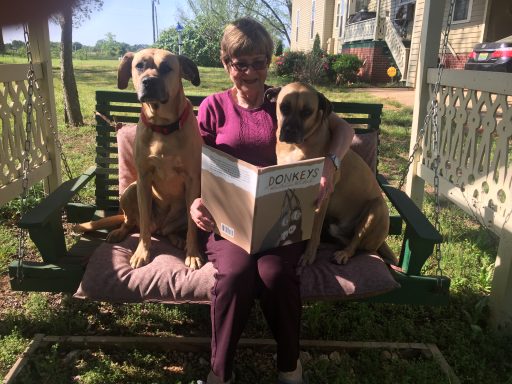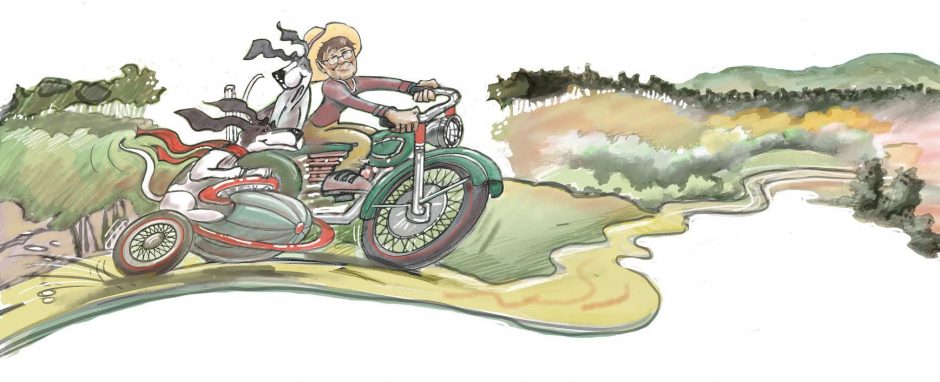DONKEY SEE, DONKEY DOO

Faye reading “DONKEYS” to Beck who seems to be enjoying the story while Rosie doesn’t seem to care.
My latest book, HALLEY, awarded 2015 Jefferson Cup Honor for Historical Fiction, awarded the Moonbeam Silver Medal for Young Adult Fiction, and awarded the 2016 Frank Yerby Award for Fiction. Available at: NewSouth Books: www.newsouthbooks.com/halley and Amazon.
I love donkeys. Always have. I started wanting one of my very own when I discovered BRIGHTY OF THE GRAND CANYON. That little burro was so independent, so loyal to his friends, so resourceful when difficulties arose, that I could not help loving him. He knew how to fight off coyotes, mountain lions, wolves, and even a few bad humans who wanted to mistreat him. Oh, I knew owning a donkey was a hopeless wish—Brighty had lived way out West, and, as far as I knew, so did all the other donkeys. They needed more space than a city yard afforded.
Time passed, and my husband and I moved to a rural area. Meanwhile, coyotes began expanding their habitat, sometimes even taking to urban areas. In our part of the country, we started hearing rumors of coyotes killing cattle. We began to hear their howling at night. Then about twenty years ago coyotes nearly killed our two dogs. Jack, the older one, was so slashed across his underbelly that the vet did not think he would survive. After that incident our dogs were fenced at night and when we were away from home.
Farmers take coyotes seriously. Losing cattle can put a farmer out of business pretty fast. Cattle farmers are more than willing to shoot predators, but coyotes are not easy targets. Poisoned bait would not only endanger other animals, such as cats and dogs, but more often than not, wouldn’t work, because coyotes are suspicious of meat with any smell of humans on or around it.
Ta-dah! Enter the Donkey! Donkeys are smarter than cows, and they can kick the daylights out of anything looking or smelling like a predator. I began seeing donkeys in among herds of cattle in our part of Alabama. Sometimes I HEARD them, too, with their distinctive “Hee-haw, hee-haw, heehaw!”
Then last year I got my own donkey—sort of. My husband and I rented a cabin for the week in Brasstown, North Carolina. The owner of the cabin had a huge pasture behind the cabin, and in that pasture was a donkey. The very first day I went out to lure him close enough to pet. He wasn’t buying. Undoubtedly, he had met a few humans who needed a good swift kick. The next day after I finished my class at the nearby Folk School, I went out to the pasture with an apple in hand. This day, Buck, as I had named him, ambled closer, but not close enough to touch. I waved the apple, sliced off a wedge, and tossed it in his direction. He ate it and moved a step or two closer to the fence with each slice until the apple was gone.
The next day when I appeared at the fence with an apple, Buck ambled over close enough to take the apple from my fingers. I managed to rub his muzzle before he retreated. By the fourth day, he came to the fence as soon as I appeared, and on the last day, he came running as soon as he heard our car drive up, bellowing, “Hee-haw, hee-haw, hee-haw!”
“And you want to listen to that every day at home?” My husband asked.
He had a point, but I wasn’t going to tell him so.
So now we’ve worked it out. I have my donkey, and once or twice a year I go to North Carolina to visit him! Last week when we were there Buck had two new friends—a shetland pony and a llama. Now I need to take three apples when I go visiting,
As Buck Owens used to say, “Hee-haw!”
This entry was posted in
Uncategorized. Bookmark the
permalink.

